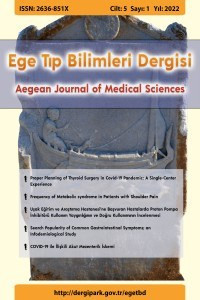Bruselloz ve Tulareminin Tarihsel yolculukları
Historical Journey of Brucellosis and Tularemia
Brucellosis, Tularemia, History,
___
- Izgur M, Doganay M. Zooneses, Bilimsel Medical Bookstore, Doganay M, Altıntas N editor, Ankara, Turkey 2009; pages 21-32
- Pappas G, Papadimitriou P, Akritidis N, Christou L, Tsianos EV. The new global map of human brucellosis, Lancet Infect Dis 2006; 6: 91–99
- Aygen B, Doğanay M, Sümerkan B, Yildiz O, Kayabas U. Clinical manifestations, complications and treatment of brucellosis: a retrospective evaluation of 480 patients, Medecine et maladies infectieuses; 32 (9), 485-493
- Tarnvik A. WHO Guidelines on Tularaemia. Umea University, Umea, Sweden; 2007
- Guven T. Neurobrucellosis: clinical and diagnostic features, Clin Infect Dis. 2013; May;56(10):1407
- Kandemir O. Brucellosis, Turkiye Klinikleri J Inf Dis-Special Topics 2015; 8(2)
- Pechous RD, McCarthy TR, Zahrt TC. Working toward the Future: Insights into Francisella tularensis Pathogenesis and Vaccine Development, Mıcrobiology and molecular Biology Rewiews 2009; Dec., 684–711
- Inci A, Yazar S, Tuncbilek A, Vatansever Z. Vectors and Vector-Borne Diseases in Turkey, Ankara Univ Vet Fak Derg 2013; 60, 281-296
- Oncel S. Brucella infections, Assessment and Management, Kocaeli Universty Health Sciences Journal 2016; September, Volume 2, Number 3
- Mariana N. Xavier, Tatiane A. Paixao, Andreas B. den Hartigh, Renee M. Tsolis and Renato L. Santos. Pathogenesis of Brucella spp. The Open Veterinary Science Journal 2010; 4, 109-118
- Kurtaran B, Candevir A, Inal AS, Komur S, Akyıldız O, Saltoglu N. Clinical appearance of brucellosis in adults: fourteen years of experience, Turk J Med Sci 2012; 42 (3): 497 505
- Capasso L. Bacteria in Two-millennia-old Cheese, and Related Epizoonoses in Roman Populations, Bacteria in Two-millennia-old Cheese, and Related Epizoonoses in Roman Populations, Journal of Infection 2002; Volume 45, Issue 2
- Vassallo MDJ. The Corps Disease: Brucellosis and Its Historical Association with the Royal Army Medical Corps, J R A rmy Med Corps 1992; 138: 140•150
- Akpınar O. Historical perspective of brucellosis: a microbiological and epidemiological overview, Le Infezioni in Medicina 2016; N. 1, 77-86
- Trevisanato SI. The ‘Hittite plague’, an epidemic of tularemia and the first record of biological warfare, Medical Hypotheses 2007; 69, 1371–1374
- Petersen J, Schriefer M. Tularemia: emergence/re-emergence, Vet. Res 2005. 36 455–467
- Dennis DT, Inglesby TV. Tularemia as a Biological Weapon Medical and Public Health Management, JAMA 2001; Vol 285, No. 21
- ISSN: 2636-851X
- Yayın Aralığı: Yılda 3 Sayı
- Başlangıç: 2018
- Yayıncı: Uşak Cerrahi Derneği
Kompleks Bölgesel Ağrı Sendromu ve Steroid Tedavisi
Levotiroksin Sodyum İntoksikasyonu: Olgu Sunumu
Şenay GÜVEN BAYSAL, Nurcan BULUR
Şizofrenili Olgularda Düşük Dereceli İnflamasyon, Lipid Düzeyleri ve Özkıyım Arasındaki İlişki
Çiğdem ÖZTÜRK TURAN, Ender UYSAL
Tüberküloz menenjitine ikincil akut başlangıçlı işitsel hallusinasyonlar: Bir vaka sunumu
Okan EKİNCİ, Gonca OĞUZ KUŞÇCUOĞLU, Betül Aydın, Aslı Ekinci
Bruselloz ve Tulareminin Tarihsel yolculukları
Gonartrozlu Hastalarda Eklem Laksitesi Değerlendirmesi; Kesitsel bir çalışma
Aliye ARSLAN TANYELİ, Zeliha ÜNLÜ
D VİTAMİN EKSİKLİĞİNİN KADIN CİNSEL FONKSİYONLARINA ETKİSİ
Seher KAYALI, Ali Yavuz KARAHAN, Neslihan SORAN, Almula DEMİR POLAT, Banu ORDAHAN, Aynur BAŞARAN, Mehmet Serdar AKKUŞ
How To Manage Extravasation Of Ibandronic Acid: A Case Report
Ender SALBAŞ, Ali Yavuz KARAHAN, Levent TEKİN, Banu ORDAHAN, Sertaç KETENCİ
